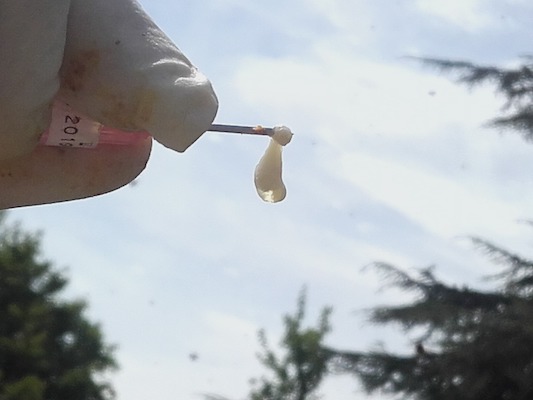 by Gérald Therville
by Gérald Therville Varroosis, caused by Varroa destructor, is a major challenge to honey bee colonies (Apis mellifera). Even with the development and successful implementation of various management strategies to control this parasite, concerns persist about the long-term effects of initial infestations on colony health and productivity.
In the Pays de la Loire region of France, the 2023-2024 beekeeping season was characterized by unfavorable climatic conditions, resulting in a poor spring harvest and necessitating additional feeding. This case study examines the persistence of varroosis signs in bee colonies despite effective management of Varroa infestation. Fourteen colonies were monitored from mid-August 2023 to spring 2024, using treatments such as Apivar®, Formicpro®, and Oxybee®. Results indicated that four colonies exhibited delayed development and persistent brood anomalies, while nine colonies progressed normally. Virological analyses revealed significant levels of DWV-B, BQCV, and SBV, and European foulbrood was confirmed in one colony. Despite reduced infestation levels, the negative long-term impacts on colony health, likely due to persistent viral infections and other factors such as queen age and nutritional deficiencies, underscored the need for proactive and continuous Varroa management throughout the season to ensure colony health and productivity.
In colonies heavily infested the previous fall and successfully managed, how does Varroa continue its negative effects?
The colonies are part of a multi-active beekeeper’s stock (about sixty colonies), with 14 of them being particularly monitored for Varroa counts on the bottom board from August 15th, 2023, to spring 2024. These colonies followed a “standard” production path in 2023 (rapeseed, all spring and summer flowers) without special parasite management during the season. The queens are from 2022 or 2023, with at least 35 kg of honey produced per hive.
One of the monitoring objectives was to verify Varroa infestation levels in colonies managed “standardly” in the french region: production colonies with no biotechnical measures during the year and summer management after the harvest. Therefore, hive monitoring was deliberately initiated from August 15th.
In 2022, the colonies received Apivar® management in summer and Oxybee® in winter (2022/2023). For summer 2023, management was adapted based on the parasitic loads observed during pre-counts from August 15th to 26th (bottom board method with bee vs, Apisfero scanner) or during clinical examination (signs of varroosis present or not).
Treatments implemented:
Winter exit assessment (April 23, 2024) noted one colony dead (with signs of varroosis and an infestation of over 8000 Varroa during the counting period). Four colonies showed delayed development, with some exhibiting persistent brood anomalies despite “low” parasitic loads. One colony showed high Varroa falls (and persistent nymph mortality since the previous summer). These prompted the consultation. The other nine colonies continued their path normally without notable Varroa-related anomalies, with varying count results.
A poor spring harvest was observed due to unfavorable climatic conditions in the region, requiring feeding for some colonies.
The raw results of cumulative falls during pre-counting are illustrated in Table 1 below (15 days before treatment), during treatment, up to 10 days after removal, 15 days after oxalic acid application, and in spring during the rapeseed honey flow.

During the August 2023 visits, anomalies in capped brood were identified in colonies 1, 2, 3, 4, 7, 8, 10, 11, and 12: nymph mortality at various developmental stages (pink to black eyes), with these anomalies limited in number (a few dozen cells scattered across brood frames), except for colony 10, which was more impacted and died in winter. A Varroa impact is probable given the signs and loads observed. Autumn visits showed persistence of these signs at lower frequencies. The spring visit (April 23) identified four lagging colonies still showing the same signs, while the other nine continued their path.
June 2, 2024 Visit:
Focused on four colonies: colonies 3, 4, 12, and 14. These showed persistent brood anomalies over time or delayed restarts in the spring visit (April 23rd). Except for colony 4, which always showed high counts, falls and counts on bees were within the season’s accepted norms. Nonetheless, varroosis or associated viral signs were observed: compact brood but with sacbrood-like larvae or dead nymphs at various stages, signs limited but persistent since the previous autumn. No signs on adult bees.
Details by colony:
Colony 3:
Colony 4: This colony was monitored for observed signs and consistently high parasite counts above the season’s accepted norm.
Colonies 12 and 14:

Colony 12:



Samples taken for virus detection related to Varroa:
Note that all samples are virus carriers, but according to current standards, bees and the queen show the most significant viral infestations.
Colony 14:
Virus and European Foulbrood Detection Samples:
Analyses confirm the presence of European foulbrood, all apiary matrices carry viruses at varying levels, including the recently born queen.
During the colony examination, and when interpretable, phoretic Varroa counts and natural mortality on bottom boards were within acceptable seasonal norms. However, persistently high mite falls on the bottom board of colony 4 raised concerns.
Testing for common viral agents yielded positive results with highly variable rates. While these results do not necessarily indicate a declared infection, they confirm the presence of viruses, even in newly born and laying queens from natural requeening.
Clinical signs observed could be attributed to DWV-B and SBV viruses, with European foulbrood confirmed in colony 14. It is also relevant to consider queen contamination. Although not unusual, in this case, queens were born less than two months ago, raising questions about vertical virus transmission.
At the end of wintering (2023/2024), 9 out of 14 colonies survived as healthy colonies ready to produce the following spring. The other 5 colonies were more severely affected:
It is crucial to emphasize that late treatment is always detrimental to colonies, impacting them in the long-term, ashighlighted here. By late summer 2023, most colonies had already reached a high parasitic threshold, posing a colony risk. Although management adaptation helped recover 2/3 of the colonies, the persistent damage initiated by Varroa and associated viruses remains evident.
It is also interesting to verify that once parasitic infestation is controlled, the colony may have experienced imbalances leading to super-organism disorganization, particularly from an immunological standpoint.
In this case, the 4 colonies showed variable evolutions:
These factors lead us to consider the overall immunity of the colony and the risks impacting it, with Varroa management being the cornerstone the previous summer.
In combating the parasite, proactive counting and visits have been shown to provide good predictions of colony health evolution. However, once colony´s equilibrium is too severely impacted, can the beekeeper still implement effective corrective measures?
Thus, this case study concludes with the need for anticipated parasite management throughout the season to keep parasitic loads below a critical threshold, protecting production, bee health, and colony health.
We would like to express our gratitude and thank Jean Luc DENECHERE for monitoring and contributing to the realization of this clinical case.
 by Juan Molina
by Juan Molina  by Ulrike Marsky
by Ulrike Marsky